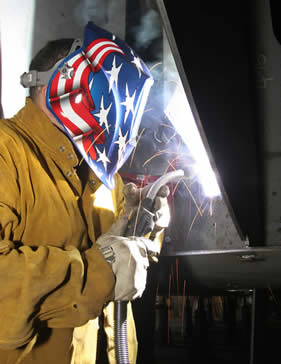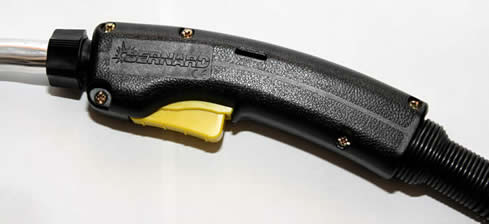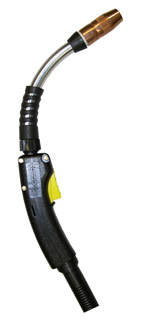Finding a MIG Gun That Fits: Stay Cool and Comfortable While Welding

A welding operator typically spends much less than 50 percent of an eight-hour day engaged specifically in the act of welding, with the remaining portion allocated to joint preparation, part fit-up and movement, and other activities that contribute to the throughput of the welding operation. Still, during that arc-on time, the importance of helping the welding operator remain comfortable and cool can’t be stressed enough. Simply stated, by ensuring good operator comfort companies can lessen the chances of injuries associated with repetitive movement, reduce overall operator fatigue and lessen insurance rates or worker compensation claims. The result? A more content employee and the potential for greater productivity and profitability.
Not surprisingly, the MIG gun that a welding operator uses can have a direct impact on comfort. Factors including the MIG gun’s amperage, along with its handle and cable styles all contribute to the equipment’s weight and maneuverability, and should be considered when selecting a MIG gun for the welding operation. Other factors, such as protecting against the MIG gun’s heat output is also critical, both to the welding operator’s comfort and safety, too.
Selecting the Right Amperage
It is not uncommon in a welding operation to find MIG guns that are rated at a higher amperage than necessary for the given application. One of the reasons for this occurrence is the common misconception that the MIG gun used should be rated to the highest amperage at which the welding operator will be welding. For example, if an application requires 400 amps, it’s very common to find a welding operator using a 400-amp gun. While the gun in this example will undoubtedly do the job, the higher amperage gun also weighs more than a lighter amperage one and tends to be less flexible—both factors that impact the welding operator’s comfort and his or her ability to maneuver the MIG gun easily.
As a general rule, selecting the lightest, most flexible MIG gun for the application is the best choice. In the case of a 400-amp application, a MIG gun rated at 300 amps may suffice. There are two reasons for this assertion.
First, MIG gun amperages, which are established by CE (Conformité Européenne or European Conformity) in Canada and NEMA (National Electrical Manufacturer’s Association) in the United States, reflect the temperatures above which the handle or the cable on a MIG gun become uncomfortable. They do not indicate the point at which the MIG gun risks damage or failure.
Secondly, given that a typical welding operator (as mentioned previously) typically welds only a small portion of the workday, it is highly unlikely that he or she would be operating the gun at full amperage and full duty cycle at all times. Duty cycle is defined by the amount of arc-on time in a 10-minute period that the equipment can be operated at maximum capacity. Some MIG guns will offer 100 percent duty cycle, while others are rated 60 percent or below.
As a result of these two factors, a lower amperage model can often be used for a slightly higher amperage application without damaging the gun or heating up to the point of making the welding operator uncomfortable. The lower amperage MIG gun also offers the added benefit of being lighter and more flexible for the welding operator. In many cases, these models will also be more cost effective.
It is important, however, to research the MIG gun’s duty cycle prior to purchasing it in order to ensure it offers the necessary capacity for the application.
Getting a Handle On the Selection

Another important factor in maintaining a good comfort level for the welding operator is selecting a MIG gun with the appropriate handle, neck and cables for the application. Typically, as a MIG gun’s amperage decreases so too does the size of the gun handle and the cable, which makes the equipment that much more comfortable for the welding operator. Because every application is different, however, it is not always possible to use a lower amperage MIG gun. For that reason, it is important to implement other safeguards to keep the welding operator comfortable.
First, it is important to match the handle style to the welding operator’s preference. MIG gun manufacturers often offer handles in curved and straight models, either of which may be more comfortable for one welding operator compared to another. The goal for both types of handles, however, is the same: to choose a light-weight, comfortable style that also meets the MIG gun and application’s amperage and duty cycle requirements. As a rule, a smaller handle will be easier for the welding operator to maneuver. Additionally, some MIG gun manufacturers offer ventilated handles, which help reduce heat and are more comfortable to hold when welding for longer periods of time. In some instances, a water-cooled MIG gun may provide the smaller size desired for an application and would be a good choice to reduce operator fatigue on higher amperage applications, especially in a shop setting.
As when selecting MIG gun or a handle, a good rule of thumb is also to select the smallest and shortest power cable possible that can still meet the needs of the application. Smaller and shorter power cables are lighter and more flexible and can, therefore, reduce operator fatigue. They can also minimize clutter in the work space and prevent excessive coiling that may be cumbersome for the welding operator to rectify and that could also lead to poor wire feeding. An added advantage is that smaller and shorter cables tend to be less expensive, as well.

In addition to fixed necks, many MIG guns are available with rotatable and flexible necks in various lengths and angles that can increase the welding operator’s comfort. The advantage of these styles is that they provide the welding operator with the option to select one that will best suit the joint access required for an application. For example, flexible necks can be easily adjusted to fit different welding angles and reach difficult joints that may be restricted or otherwise awkward to reach. This features helps keep the welding operator from straining to reach a particular weld joint and risking fatigue or injury. Similarly, rotatable necks are a good option for welding out-of-position (including overhead), as they can be adjusted to reach the weld joint without changing the gun handle or its position. Both of these type of MIG gun necks can also simplify inventory and reduce downtime for neck changeover, as they can be used on multiple applications. Some MIG gun manufacturers also offer neck couplers, which allow the welding operator to connect multiple necks together to reach especially difficult joints comfortably.
Staying Cool
There are two main types of heat in a welding operation: radiant heat from the arc and resistive heat from the cable. To protect against both types of heat, it is important that the welding operator always wear the proper protective apparel, including a helmet, welding gloves and a welding jacket or sleeves.
Radiant heat is heat that reflects from the welding arc and base metal back to the handle. If the welding operator welds on shiny materials, such as aluminum or stainless steel, it will likely reflect more heat that a duller mild steel, for example. Using a longer neck to the MIG gun can help protect the welding operator from radiant heat by placing the handle further back from the arc. Adding a neck grip can further increase comfort. Neck grips are available through select MIG gun manufacturers and are usually composed of high-temperature silicon rubber. They slide over the neck to protect the welding operator from heat exposure and related fatigue. These accessories offer the added benefit of increasing control for welding operators who like to rest the neck on their hand or forearm, using it as a pivot point to maneuver the MIG gun.
Because the neck can also carry heat to the handle, it is important to use front-end consumables—nozzles, contact tips and diffusers—that remain cool. Be certain to look for consumables that fit snugly together, as this feature will minimize electrical resistance and reduce heat output.
Also, consider the shielding gas being used for the applications as a means to minimize heat in the welding operation and help the welding operator remain cooler. Argon, for example tends to create a hotter arc than does pure CO2 shielding gas. In fact, MIG guns operating with Argon in the mix often reach the MIG gun’s rated temperature at a lower amperage than when using pure CO2. While it may not be possible to choose which shielding gas to use (a particular application often specifies gas usage), if operating an Argon applications, a welding operator could take other precautions (as mentioned above) to help stay cool.
To protect against resistive heat, it is important to have a large enough power cable for the job—but not too large as to make it difficult to maneuver—and also to prevent kinking of the power cable whenever possible.
Putting It All Together
When selecting a MIG gun for any application, the goal is two-fold: to have the right equipment for the application and to keep the welding operator as comfortable as possible. Through careful selection of the proper amperage MIG gun, along with choosing an appropriate handle, cable and neck that goal is reasonable to achieve. Also, by taking precautions against heat exposure, a welding operator can ensure that he or she will be able complete the required welds with minimal discomfort. Remember to research the MIG guns available in the market place, in addition to the application at hand. Consider the actual amount of time the welding operator will be welding and on what type of material, too. Doing so can help ensure that the selected MIG gun strikes a good balance between size and capacity.


